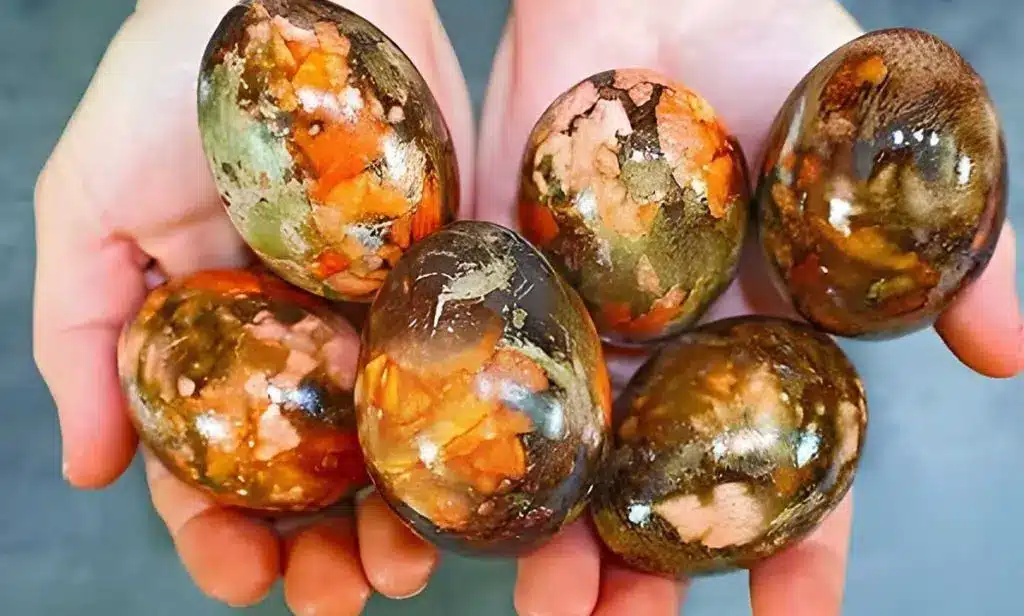
It was a quiet Saturday morning when Helen decided to finally work on the garden bed near the old shed. The soil was soft from recent rain, and she was hoping to replant some herbs. As she dug, her trowel scraped something unexpectedly smooth. Curious, she pushed aside more dirt and found a cluster of round, colorful objects nestled together.
They were unlike anything she’d seen before — shiny, speckled, and painted in hues of green, orange, and deep blue. At first, she thought they were plastic, maybe remnants of an old Easter hunt. But they were heavier, and the surface felt oddly natural. She carefully scooped them into a basket and brought them up to the porch.
Helen’s son, Max, was sitting at the kitchen table scrolling through his phone when she walked in. “You’ve got to see these,” she said. He looked up, intrigued by the weirdly beautiful objects in the basket. Max picked one up gently, turning it in his hand. “These feel real,” he said. “Like… actual eggs?” Helen nodded. “That’s what I’m wondering.”
They both sat down and examined the collection. Each egg was about the size of a small apple, with glossy shells covered in natural-looking patterns. Some looked marbled. Others were spotted like pebbled stone. Helen was fascinated. “Do you think they’re bird eggs?” she asked. Max shrugged. “I’ve never seen any like this. Not even online.”
Max snapped a few photos and posted them to a local wildlife identification group. Within minutes, comments started pouring in. Most people were just as puzzled, but a few offered real insight. One user suggested they might be from a species of ornamental fowl. Another pointed out the mineral sheen could mean they were preserved, not fresh.
Helen started to worry. “Do you think they’re dangerous? Like maybe they’ve gone bad?” Max shook his head. “No smell. And they’re not warm. I don’t think anything’s alive in there.” Still, they decided to keep them in the shade and avoid touching them too much. Max promised to dig deeper into the research and find out more.
The next morning, Max got a reply from someone who worked at the nearby university. A biology professor named Dr. Patel asked if he could come take a look in person. “That’s a good sign,” Helen said. “At least someone’s taking them seriously.” Max agreed and replied with their address. Dr. Patel arrived that afternoon with a small kit and a smile.
He was fascinated the moment he saw them. “These are not eggs from any common wild species,” he said, carefully holding one up to the light. “But they’re definitely real.” He explained that some birds, particularly in tropical climates, lay brilliantly colored eggs — and occasionally, domestic species crossbreed in strange ways. But these? These were different.
Dr. Patel ran a quick test with a handheld scanner and chuckled. “Ah, here we go,” he said. “They’re preserved. These were chemically sealed, likely for educational purposes.” Helen looked surprised. “So they’re not going to hatch?” He shook his head. “No, but they’re not fakes either. They’re genuine — just not alive anymore.”
He went on to explain that the eggs were likely part of an old classroom or science kit from decades ago. Back then, natural specimens were often preserved using non-toxic resin coatings, which explained their glossy texture. “It’s actually pretty rare to find a full set like this still intact,” he added. “These are in amazing condition.”
Max was thrilled. “So we found something valuable after all?” Dr. Patel smiled. “More like meaningful. These would be perfect for a local museum or nature center.” Helen offered to donate them, and within a few days, the eggs were packed up carefully and taken to the town’s small natural history exhibit for display.
Word spread quickly through the neighborhood. Friends and neighbors came by to see photos and hear the story. “Who knew your backyard had artifacts?” one neighbor joked. Helen laughed. “I always said the garden needed more color. I just didn’t expect it to come from underground.” She found herself checking the soil more often, just in case.
Max wrote a short piece about the discovery for his school blog. He included photos, facts from Dr. Patel, and even a fun timeline of how it all unfolded. It was the most-viewed article of the semester. “Turns out mystery eggs are a big deal,” he said. Helen beamed. “Better than weeds, I guess.”
In the weeks that followed, Helen and Max worked together to clean up the rest of the garden bed. They planted herbs, wildflowers, and a new patch of sunflowers. But they also placed a small plaque at the site that read: “Discovery Spot — March 2025.” It was a simple reminder of something unexpected, beautiful, and totally real.
They never found anything else buried in the yard, but that was okay. The experience had brought them closer together, sparked local curiosity, and even led to a field trip for Max’s science class. For Helen, it made the backyard feel a little more magical. For Max, it made him realize how cool real-life mysteries could be.
Sometimes, the most interesting things don’t come from books or movies — they’re just waiting beneath your feet, buried in soil, wrapped in color, and ready to be found. Helen still tells the story to new visitors. And every time she does, she ends it the same way: “All I wanted was fresh herbs. What I got was a museum piece.”


